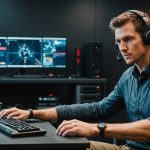Creating your first gaming PC is a thrilling endeavor that promises a world of high-performance visuals and immersive gameplay. However, diving into the world of PC building can be daunting, especially with the myriad of components and technical specifications involved. As you embark on this journey, understanding the common mistakes that many first-time builders make can save you time, money, and frustration. This article will guide you through potential pitfalls and ensure that your gaming system delivers the maximum performance you desire.
Choosing the Right Components
Selecting the correct components is crucial when building a gaming PC, as it directly affects your system’s performance. Missteps at this stage can lead to compatibility issues and bottlenecks in performance.
In parallel : What are the advantages of using a gaming router for online play?
CPU and Motherboard Compatibility
The CPU (Central Processing Unit) is the brain of your PC, and its compatibility with the motherboard is non-negotiable. Ensure that the socket type and chipset of the motherboard match your chosen CPU. Research the latest models and evaluate them based on your performance needs and budget.
RAM: Go for DDR4 or DDR5
When considering RAM, it’s essential to choose the right DDR version. While DDR4 is still widely used, DDR5 promises better performance and is becoming more affordable. Aim for at least 16GB, which will future-proof your system for most gaming requirements.
Have you seen this : What are the best practices for maintaining and cleaning your PC hardware?
Graphics Card: Performance and Budget
The GPU (Graphics Processing Unit) is pivotal in ensuring smooth gameplay. Mistakingly opting for a GPU that doesn’t match your gaming needs or budget is a common error. Research thoroughly and look for user reviews to decide which GPU fits your performance goals.
Power Supply: The Unsung Hero
A power supply that’s inadequate for your build’s needs can lead to system instability. Calculate your PC’s power consumption and ensure the supply exceeds it by a comfortable margin. Quality power supplies ensure reliability and longevity for your system.
The Importance of Proper Cooling
Effective cooling is essential to maintain performance and extend the lifespan of your PC’s components. Many first-time builders underestimate the importance of keeping their system cool, leading to overheating and performance throttling.
Air vs. Liquid Cooling
When deciding between air and liquid coolers, consider your build’s requirements and budget. Air coolers are more affordable and easier to install, while liquid coolers offer superior performance for overclocking.
Case Airflow and Fan Placement
Your case’s design significantly impacts cooling efficiency. Choose a case that supports good airflow and has ample space for additional fans. Ensure that fans are positioned to create a balanced intake and exhaust flow, preventing heat from accumulating inside the case.
Regular Maintenance
Neglecting regular maintenance, such as cleaning dust from fans and coolers, can lead to performance issues. Schedule periodic cleanings and check fan functionality to ensure optimal performance.
Avoiding Static Damage During Assembly
Static electricity is an unseen foe that can wreak havoc on your delicate components during assembly. Taking precautions against static discharge can save you from damaging expensive parts and ensure a smooth build process.
Use an Anti-static Wristband
An anti-static wristband is a simple and effective tool to ground yourself. It helps in dissipating any static charge and prevents it from transferring to the components.
Work on a Non-conductive Surface
Always assemble your PC on a non-conductive surface, such as a wooden table or an anti-static mat. Avoid carpets and other surfaces where static can build up easily.
Keep Components in Anti-static Bags
Until you’re ready to install them, keep your Motherboard, GPU, and other sensitive parts in their anti-static bags. Handling them directly without protection increases the risk of static damage.
Testing and Troubleshooting Your Build
Once your PC is assembled, it’s crucial to ensure that everything functions as expected. Testing and troubleshooting are vital steps that many first-time builders tend to overlook, leading to performance issues later.
Double-Check Connections and Components
Before powering on your build, double-check all connections. Ensure that components are seated correctly and that cables are secure. A loose connection can lead to anomalies and performance hiccups.
Perform a BIOS Update
Updating the BIOS can resolve compatibility issues and improve performance. Check your motherboard manufacturer’s website for the latest version and follow their instructions carefully.
Run Stress Tests
Use stress-testing software to evaluate your system’s stability. Programs like Prime95 and FurMark test your CPU and GPU under load, identifying any instability or overheating. This step helps in fine-tuning your build for peak performance.
The allure of building your own gaming PC lies in the ability to customize every aspect to match your specific requirements. While the process can be intricate and challenging, avoiding these common mistakes will save you from common pitfalls encountered by first-time builders. With the right knowledge and precautions, your journey into PC building can be rewarding, yielding a high-performance machine ready to conquer the latest games. Equip yourself with patience and diligence, and you’ll soon revel in the performance and satisfaction that a well-built gaming PC can deliver.











